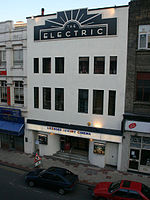10 Holloway Circus
Buildings and structures in Birmingham, West MidlandsResidential buildings completed in 2006Residential skyscrapers in EnglandSkyscraper hotels in EnglandSkyscrapers in Birmingham, West Midlands ... and 1 more
Use British English from January 2014

10 Holloway Circus (also referred to as the Holloway Circus Tower or Beetham Tower) is a 400-foot (122 m) tall mixed-use skyscraper in Birmingham city centre, England. It was originally named after the developers, Beetham Organisation, and was designed by Ian Simpson and built by Laing O'Rourke. The entire development covers an area of 7,000 square feet (650 m2). It is the second tallest building in Birmingham and the 74th tallest building in the United Kingdom.
Excerpt from the Wikipedia article 10 Holloway Circus (License: CC BY-SA 3.0, Authors, Images).10 Holloway Circus
Holloway Circus Queensway, Birmingham Digbeth
Geographical coordinates (GPS) Address External links Nearby Places Show on map
Geographical coordinates (GPS)
| Latitude | Longitude |
|---|---|
| N 52.475405555556 ° | E -1.9001638888889 ° |
Address
Radisson Blu hotel
Holloway Circus Queensway 12
B1 1BT Birmingham, Digbeth
England, United Kingdom
Open on Google Maps







